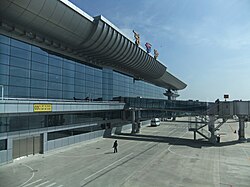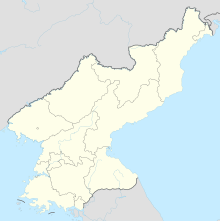Pyongyang International Airport
This article needs to be updated. (January 2021) |
Pyongyang International Airport 평양 국제비행장 | |||||||||||||||
|---|---|---|---|---|---|---|---|---|---|---|---|---|---|---|---|
 | |||||||||||||||
 Terminal 2 | |||||||||||||||
| Summary | |||||||||||||||
| Airport type | Public | ||||||||||||||
| Owner | Government of North Korea | ||||||||||||||
| Serves | Pyongyang, North Korea | ||||||||||||||
| Location | Ryongbung-ri, Sunan District, Pyongyang, North Korea | ||||||||||||||
| Hub for | Air Koryo | ||||||||||||||
| Elevation AMSL | 36 m / 118 ft | ||||||||||||||
| Coordinates | 39°13′26″N 125°40′12″E / 39.22389°N 125.67000°ECoordinates: 39°13′26″N 125°40′12″E / 39.22389°N 125.67000°E | ||||||||||||||
| Map | |||||||||||||||
 FNJ/ZKPY Location in North Korea | |||||||||||||||
| Runways | |||||||||||||||
| |||||||||||||||
Sources: Flightradar24 - FNJ/ZKPY | |||||||||||||||
| Pyongyang International Airport | |
| Chosŏn'gŭl | |
|---|---|
| Hancha | |
| Revised Romanization | Pyeongyang Gukje Bihaengjang |
| McCune–Reischauer | P'yŏngyang Kukche Pihaengchang |
Pyongyang International Airport (Korean: 평양 국제비행장; Hanja: 平壤國際飛行場; MR: P'yŏngyang Kukche Pihaengchang) (IATA: FNJ, ICAO: ZKPY), also known as the Pyongyang Sunan International Airport,[1] is the main airport serving Pyongyang, the capital of North Korea. It is located in the city's Sunan District. As of March 2019, Air Koryo and Air China are servicing Pyongyang International Airport, and the only two foreign countries served by Pyongyang International Airport are China and Russia.
History[]
Early years[]
During the period of Japanese occupation, two airports were built in Pyongyang. Pyongyang Air Base was built by the Empire of Japan in the 1940s and remained in use until the 1950s. A second airport, Mirim Airport, was also built by the forces of the empire of Japan in the 1940s and located east of the Taedong River. However, after World War II there was a need for a newer airport, and Sunan Airfield was constructed. Mirim Airport survived as a military airfield with Pyongyang Air Base re-developed for use by the government and housing.
During the Korean War, the airport was occupied by United Nations forces for seven weeks in late 1950. The forces flew large amounts of supplies to Sunan during this period. On 13 May 1953, the airport was inundated when the US Air Force bombed Toksan Dam. After an armistice was signed two months later, the North Korean Government started repairing and expanding the airport.[2]
Soviet flag carrier Aeroflot was providing flights to Moscow and Khabarovsk in the mid-1980s.[3] It was still serving Pyongyang in 1993 after the fall of the USSR, but eliminated the North Korean capital from its network sometime during the next two years.[4][5] Meanwhile, Air Koryo offered a nonstop link to Europe during the 1990s. The airline was using Ilyushin IL-62s to fly to Moscow in 1998, with onward connections to Berlin and Sofia; however, it had ceased flights to all three destinations by 2002.[6][7]
Development since the 2000s[]
Russian Sky Airlines operated charter services to Pyongyang from Russian destinations during the mid 2000s operated by Il-62M and Il-86 aircraft.[8][9][10][11] China Southern Airlines offered scheduled charter flights to and from Beijing during the peak season only, and permanently pulled its flights in October 2006.[12] In March 2008, Air China re-established service to Beijing on a Boeing 737, three days a week,[13] and suspended due to lack of demand on 22 November 2017.[14] Air Koryo,[15] Korean Air and Asiana Airlines also provided chartered flight services to Seoul and Yangyang on the east coast of South Korea from Pyongyang. These flights were used by Korean family members visiting divided family across the border; these services were halted after the ending of the Sunshine Policy by South Korea in 2008.[10] In June 2018, Air China resumed service from Beijing Capital Airport to Pyongyang.[16]
Modernization[]
By early 2011, an interim facility handling international flights had been constructed just south of the existing terminal. By early 2012, demolition of the existing terminal, which Kim Jong-un deemed too small and outdated, had begun. In July 2012, he ordered the construction of a new terminal.[17] Besides this, a new control tower and VIP terminal north of the main terminal were also constructed.[18] The project became part of a "speed campaign", in which thousands of workers were enlisted to quickly complete it.[19]
September 2017 missile test[]
On September 15 at about 6:30am KST, North Korea fired a Hwasong-12 missile from the airport. The missile travelled 3,700 kilometers (2,300 mi) and reached a maximum height of 770 kilometers (480 mi).[20]
Infrastructure[]
| External video | |
|---|---|
Pyongyang International Airport has two passenger terminals. Terminal 1 opened in January 2016 and solely handles domestic flights.[21] It is connected to Terminal 2,[21] the international terminal that was inaugurated on 1 July 2015.[22] The terminal has jet bridges and at least 12 check-in counters.[23][24] Amenities include a duty-free store, coffee bar, newsstand and Internet room,[24][25] along with a snack bar, pharmacy, CD/DVD shop and electronics shop.[26]
Business class lounge with buffet is on the upper level along with outdoor viewing area.[26]
The airport has one functioning runway which is designated 17/35 and measures 3,800 by 60 metres (12,470 ft × 200 ft).[27] Another runway, 01/19, is not in use as of 2013.[28][1]
Yonhap reported in September 2016 that a maintenance facility had been constructed at the Pyongyang airport. Located about 1 kilometre (0.62 mi) from runway 17/35, the facility includes aircraft hangars and apartment buildings for high-ranking officials and Air Koryo employees.[29]
During the construction period a hangar like structure served the airport with basic services (baggage carousel), as well as duty-free shop, bookshop/souvenir shop.[30]

The former terminal. (2006)

First Class Lounge in the former terminal
Duty-free shop in the former terminal

New terminal interior

Business class lounge

Air Koryo Tupolev Tu-204-300 (P-632) at Pyongyang Sunan's Terminal 2

Pyongyang Airport Terminal 2

Sunan international airport, September 2010
Airlines and destinations[]
Pyonyang-Sunan serves 8 destinations to three countries with two airlines.
| Airlines | Destinations |
|---|---|
| Air China | Beijing–Capital[16] |
| Air Koryo[31] | Beijing–Capital, Chongjin, Macau,[32] Samjiyon, Shenyang, Sinuiju, Vladivostok, Wonsan |
Access[]
The airport is located approximately 25 kilometres (16 mi) from the city,[33] about a 30-minute drive by the Pyongyang-Hicheon Expressway.[34] In addition, Sunan Station located on the Pyongui Line of Korean State Railway is located 800 metres (2,600 ft) away from the Pyongyang airport terminal building.[35]
See also[]
- Mirim Airport
- Pyongyang Air Base
- Transport in North Korea
- Wonsan Kalma International Airport
References[]
- ^ a b "Pyongyang Intl -- ZKPY". World Aero Data. 2006. Retrieved 2 February 2017.
- ^ Corfield, Justin (2014). Historical Dictionary of Pyongyang. London, UK and New York, NY: Anthem Press. p.198.
- ^ "1985/86: AEROFLOT Network". Routesonline. 2 March 2011. Retrieved 12 June 2021.
- ^ "World Airline Directory: Aeroflot – Russian International Airlines". Flight International. 24–30 March 1993. p. 44. Retrieved 7 June 2012.
- ^ "World Airline Directory: Aeroflot - Russian International Airlines (ARIA)". Flight International. 29 March – 4 April 1995. p. 45. Archived from the original on 14 June 2014.
- ^ "Air Koryo timetable". 1998. Retrieved 12 June 2021.
- ^ "Air Koryo timetable". 2002. pp. 18–20. Retrieved 12 June 2021.
- ^ "✈ russianplanes.net ✈ наша авиация". russianplanes.net.
- ^ "✈ russianplanes.net ✈ наша авиация". russianplanes.net.
- ^ a b Willoughby, Robert (2014). North Korea: The Bradt Travel Guide. Guilford, CT: The Globe Pequot Press Inc. ISBN 978-1-84162-476-1.
- ^ "1985/86: AEROFLOT Network". Airline Route. 2 March 2011. Retrieved 29 December 2015.
- ^ "China Southern to Halt Pyongyang Flights". The Chosun Ilbo via China Aviation Daily. 19 October 2006. Retrieved 29 December 2015.
- ^ Rabinovitch, Simon (31 March 2008). "Air China launches flights to North Korea". Reuters. Retrieved 29 December 2015.
- ^ "Pyongyang flights suspended due to lack of demand". China Daily. Retrieved 23 November 2017.
- ^ "air koryo | 2003 | 2045 | Flight Archive". Flightglobal.com. Retrieved 12 February 2018.
- ^ a b "Air China resumes Pyongyang service from June 2018". routesonline.com.
- ^ "10 things to know about North Korea's new airport terminal". The Straits Times. 2 July 2015. Retrieved 29 December 2015.
- ^ "North Korea to open new terminal at Pyongyang Sunan International Airport". Airport Technology. 26 June 2015. Retrieved 29 December 2015.
- ^ "North Korea enlists thousands of workers to finish new airport". Associated Press via The Guardian. 22 October 2014. Retrieved 29 December 2015.
- ^ "North Korea 'fires missile from Pyongyang'". BBC. 15 September 2017. Retrieved 15 September 2017.
- ^ a b "Terminal 1 of Pyongyang Sunan Int'l Airport starts operation in DPRK". Xinhua News Agency. 26 February 2016. Retrieved 2 February 2017.
- ^ "With much fanfare, fancy new terminal opens at Pyongyang's international airport". U.S. News & World Report. Associated Press. 1 July 2015. Retrieved 2 February 2017.
- ^ Shim, Elizabeth (2 July 2015). "North Korea: Airport terminal is 'new face' of country". United Press International. Retrieved 2 February 2017.
- ^ a b "10 things to know about North Korea's new airport terminal". The Straits Times. Singapore. 2 July 2015. Retrieved 2 February 2017.
- ^ Talmadge, Eric (27 August 2015). "North Korea's shiny new airport falls short of expectations". The Guardian. Associated Press. Retrieved 2 February 2017.
- ^ a b Chui, Sam (30 September 2016). "Review: Air Koryo Business Class Lounge and Pyongyang new terminal". SamChui.com.
- ^ "ZKPY - Pyongyang Airport". SkyVector. Retrieved 2 February 2017.
- ^ Corfield, Justin (2013). Historical Dictionary of Pyongyang. London, UK: Anthem Press. p. 198. ISBN 978-0-85728-234-7.
- ^ "N. Korea builds large-scale maintenance complex for Air Koryo planes: report". Yonhap. 1 September 2016. Retrieved 2 February 2017.
- ^ "North Korea races to build new international airport in Pyongyang". Traveller. 24 October 2014.
- ^ "timetable". airkoryo.com.kp.
- ^ "Air Koryo plans Macau service increase from late-Oct 2019". Routesonline.
- ^ "Map of Sunan-Pyongyang airport". 25 June 2015. Retrieved 18 February 2021.
- ^ The Rough Guide to Korea. Rough Guides. 2015. ISBN 978-0-241-24637-5.
- ^ "平壌~北京間国際列車-平壌→定州". www.2427junction.com. Retrieved 21 June 2017.
External links[]
![]() Media related to Sunan International Airport at Wikimedia Commons
Media related to Sunan International Airport at Wikimedia Commons
- 360° virtual tour of the airport – DPRK 360 photography project
- Accident history for FNJ at Aviation Safety Network
- Airports in North Korea
- Transport in Pyongyang








